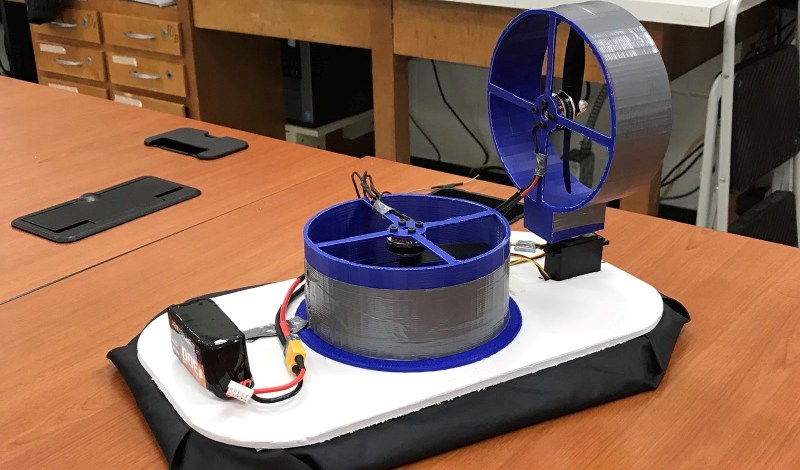Instructables user [John_Hagy] and some classmates built an RC hovercraft as their final project in the Robotics Education Lab at NC State University. It’s a foam slab with a Hovership H2204X 2300Kv brushless motor inflating a skirt made out of ripstop nylon. Nylon is great here because it has a low friction coefficient and is nonporous to keep the air in. A second motor propels the craft, with a servo turning the whole motor assembly to steer. The team designed and 3D-printed fan holders which also help channel the air to where it’s supposed to go. Control is via a typical radio-control transmitter and receiver combo.
The project writeup includes a lot of fun detail like previous versions of the hovercraft as well as the research they undertook to learn how to configure the craft — clearly it’s their final paper put on the internet, and well done guys.
Needless to say, we at Hackaday can’t get enough of this sort of thing, as evidenced by this cool-looking hovercraft, this hovercraft made on a budget and this solar-powered ‘craft.















Kinda cool. I worked on hovercraft development decades ago, akways enjoyed the testing! ;)
Some weights would be nice if they could find a scale.
I can’t help but think a cardboard tube would be faster and lighter to make.
Now a 3D printed blower. …. maybe get super fancy and divide the output for both lift (I’m not sure what the right term is but that doesn’t sound like it) and propulsion
Lift is the correct term. Hovercraft engineering and operations has always used aeronautics terminology.
It came as quite a surprise to hear Hoverspeed’s staff, both booking staff at the terminal and ‘aircrew’ on board, describe the crossing as a ‘flight’ the first time I used their service.
Well, it certainly has manoeuvrability of an aircraft, i.e. it will take a lot of space to stop, or to make a turn.
Nice
What I love about online community is that you can find many of things already done and ready to go.
For example this nice 3D printed hovercraft – had I had to make it, I’d also print a few of these too https://www.thingiverse.com/thing:1878365
Can someone familiar with the terminology explain the “2300Kv”? Pretty sure this doesn’t refer to kiloVolts, or kilowatts…
Offhand, I believe it’s a constant: the RPM of the motor per volt applied (assuming no load)
Here’s a website I found: http://www.flyelectric.com/ans.kv.html
It’s commonly used to denote rpm/Volt. So at 4V, one can expect 9200 rpm
It’s a factor that describes the ratio of RPM to volts. IIRC the v should be written as a subscript.
My first sucessful project was in middle school when I built a hovercraft out of old computer fans. My teacher didn’t believe me it worked because it needed a powersupply to fly. (I was on a budget)
My high school’s electronics lab had a few hovercrafts, they were just a circle of plywood covered in a thick plastic sheet with holes punched in it, center of the wood had a hole with a leafblower motor fitted to it. They worked more on the principle of an air hockey table as the air cushion wasn’t very big, and it needed a flat smooth surface to work on.
Man, this project is just screaming for an ESP8255 or ESP32. I really want to make one of these and be able to control from a web or mobile app!
er, ESP8266. dang keyboard!!!
They should be introduced to the stator vane. For that type of application having a fan alone is highly inefficient. Simply putting stator vanes behind the fan should increase the pressure dramatically. Having two counter rotating fans would be much more efficient even but a bit more complex.